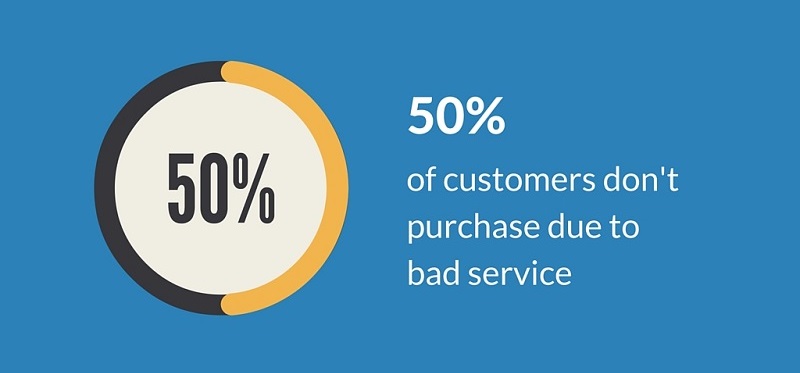Topics
A Guide to Social Customer Service

Customer service has always been a crucial part of doing business, but in the modern digital economy, where word-of-mouth travels around the world in seconds, it’s more important than ever to get it right. Any poor interactions with a customer can quickly spread through online media, damaging a company’s reputation and bottom line. Roughly $41 billion per year are lost in the United States due to poor customer service, and 93% of customers will take action after having a bad experience.

The use of social media in today’s connected society has opened new avenues for companies to interact with their customers. Twitter, Facebook, Instagram, YouTube and other social media outlets allow the public to interact directly with companies. With the increased accessibility, however, the public has come to expect that companies using social media will also interact with them.
Technology research company Gartner Inc. reported that those organizations who failed to respond to the public on social media have seen a churn rate of up to 15% among their customers. With so much riding on interaction with the public via social media sites, no company can afford to ignore the opportunities that the medium can offer.
The Power of the Public
Along with the revelation that social media can help business, the public has become aware that the power of Twitter and other outlets gives them a certain level of influence over companies. With the ability to post complaints or compliments online for everyone to see, customers themselves can have a direct impact on businesses.
Two cases in point:
- Amazon and Reddit – An Amazon customer reported to the company that his package had not arrived, and had been lost by the US Postal Service. Despite the fact that Amazon was not at fault, their customer service refunded him the cost of the purchase. The happy customer posted the story on the social website, Reddit, and the post quickly went viral, with over 800,000 views.
- FedEx and YouTube – When a customer came home to find that FedEx had delivered his new computer monitor by throwing it over his fence and smashing it, he posted security camera footage of the incident on YouTube. The video received nearly 9 million views, and FedEx responded by apologizing for the poor service. They also refunded the customer for the cost of the monitor.

When customers have negative experiences with a brand, they look to find answers online. Should the online search fail, they contact the company via phone. Many complaints can be resolved, but out of those who become even more aggravated by the phone call, an estimated 16% will make an online post about their dissatisfaction.FedEx and YouTube – When a customer came home to find that FedEx had delivered his new computer monitor by throwing it over his fence and smashing it, he posted security camera footage of the incident on YouTube. The video received nearly 9 million views, and FedEx responded by apologizing for the poor service. They also refunded the customer for the cost of the monitor.
What Companies Need to Do
With consumers having very public outlets though social media, it is important to pay attention to what they are saying, and ensure that staff can provide great customer service via online forums. There are a few things that companies need to keep in mind when integrating social media into their customer experience program:
Understand Your Customers
Knowing how customers talk about a brand online is a critical first step in creating customer service integration. Companies need to know which information matters, then leverage it to learn how consumers feel about a product or service. This information can also help a business measure engagement with the brand, helping to reduce churn.
Online customer service complaints across available social media outlets have various degrees of influence. For example, a popular YouTuber, or other celebrity who complains about a company will have a much wider reach than an average citizen. Knowledge of a company’s followers will help to stop complaints from those people before they become viral and cause problems.
Likewise, this information can be used to ensure that influential followers have the best experience possible. If one of these influencers were to tweet about what great service they had with a company, it can easily be seen by thousands of people, creating greater brand awareness. This is similar to restaurants knowing who food critics are, and helping them have the best possible experience while dining at an establishment.
In 2015, Kim Kardashian’s endorsement of Diclegis, a drug which prevents morning sickness, was posted on the celebrity’s Instagram account. At the time, Kardashian was pregnant with her second child and experienced significant morning sickness despite her best efforts. Her tweet went viral, and the post managed to gather 450,000 likes.
The result was a win for drug manufacturer Duchesnay. Their brand awareness had suddenly increased among Kardashian’s 42 million followers. It was also reported that there was a 500% increase in online “chatter” about Diclegis due to the tweet.
Spot Trends, and Use Them
Trends found in social media are much more current than the information found in databases. Capturing and using this information will give a company an edge over those who do not, as they can react to changes in the social sphere, and give customers the service they desire.
Analysis of existing social media sources can be used to determine where it should be assigned within a business, as well as any action that may be required, and the people within the organization who are best suited to take that action. Businesses who analyze the data and use it to escalate customer service from the social sphere to assisted service will drastically improve a customer’s experience with the company.
Gathering knowledge of the customer base is important, but it is equally important that a company act on that knowledge. Application of data to create new customer experiences through social media shows that a company is listening to its consumers, and is working to create improved interactions between the brand and the public.
Talk to the Target Audience
Responding to customer comments in social media is crucial for showing that a business is listening and responding to its audience. Comments are best responded to by posting in the same media that the comment was originally made, even if it is only suggesting that the discussion be moved to a private channel. Prompt responses to customers reflect favorably on the company when it comes to public opinion.
Proactive efforts also help increase customer service satisfaction by showing that businesses are reaching out to the public and keeping them aware of new developments. Using the information gained from social media, businesses can appeal to the demographics most likely to be interested in products or services.
Combine Customer Service across Media
In order for customers to feel that they are receiving a coordinated, and consistent customer experience, it’s important for a company to integrate services across various channels. Since not every issue can be resolved through social media, customers need to be able to switch to other platforms that involve human interaction. Email, phone or online chat are all avenues that can be included in strategies.
Each channel, however, needs to have access to the information provided by social media, otherwise the effort of collecting the data is wasted if it cannot be used to inform the next service agent who interacts with the customer. Customers frequently become irritated when having to repeat themselves to multiple agents, and companies which simply eliminate the need for a customer to repeat their stories will help to boost satisfaction with their service.
Finally, some estimates state that between 2% and 10% of calls to customer service could have simply been resolved through social media forums. Integration of an enterprise knowledge base with a company’s online forums can help reduce the number of calls to customer service centers and give the public faster, more efficient resolutions.
Final Word
In the world of customer service, it costs much more to replace an unhappy customer than it is to keep a satisfied one. Companies should leverage online social media outlets to their advantage by interacting directly with their customers, whether to promote new products and services or help address and resolve complaints. Either way, customers will have a better experience and are more likely to be loyal to a brand where they feel appreciated.
Knowledge gained from social media analytics can help streamline company processes, resulting in faster service for customers and a cost-savings for businesses. Implementing that knowledge helps organizations reach an audience that is most interested in the product, and achieve a favorable ROI in social media customer service.
References:
Gartner Inc. (2012, August 1). Gartner Predicts That Refusing to Communicate by Social Media Will Be As Harmful to Companies as Ignoring Phone Calls or Emails Is Today.
Heine, C. (2015, August 11). FDA Rebukes Kim Kardashian for Morning-Sickness Drug Ad on Instagram But Pharma Marketer Diclegis Wins Big Anyway.
When Customer Service Goes Viral: The Good and the Bad. (n.d.). Retrieved from Daily Finance.

